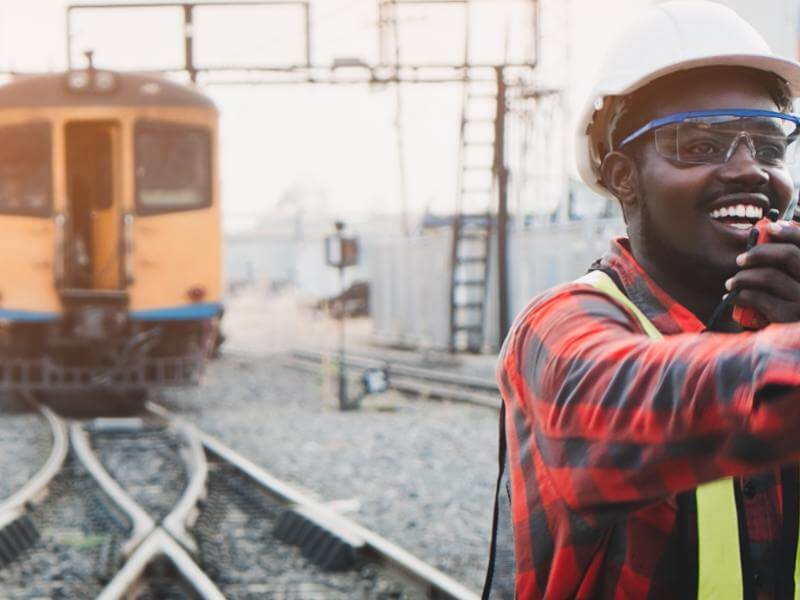
Our Projects are
Transforming African Trade
Quick Contacts
2nd Floor, Fidelity Insurance Centre Waiyaki Way, Westlands

Globally, much movement is underway in transitioning the transportation sector to cleaner fuel sources, and even more so across Africa. Of note is continent-wide efforts to resuscitate the rail sector.
Due to its energy efficiency, reduced greenhouse gas emissions and lower cost per ton kilometre, rail transportation can play a crucial role in Africa’s industrialisation efforts. This market is vital to delivering on the promise of the African Continental Free Trade Agreement.
Here is a snapshot of four projects addressing the need for rail transport infrastructure development this year so far.
Apart from new build programmes, committing to continuous maintenance works on existing rail infrastructure is essential. One critical area for railway infrastructure is turnout sets. These rail configurations allow trains to change tracks smoothly without stopping.
These sets also allow trains to re-route to avoid congestion and delays and to operate around maintenance work.
For example, an important rail line in South Africa that connects the country’s coal to international markets experienced several such breakdowns, affecting mining companies’ ability to evacuate their coal export during H1 of 2023.
Relief was reported in September after installing 18 sets during the annual July shutdown of the coal line from Lephalale in Limpopo through Mpumalanga to the Port of Richards Bay in KwaZulu-Natal. More work is underway.
Register for Smarter Mobility Africa, taking place 1-3 October 2023 at Gallagher Estate in Gauteng. Use promo code ESI20MP to get the insider’s 20% discount on your ticket.
Of course, besides maintenance programmes, there is a significant need for rail development across all African regions.
Highlighting this need are the efforts to boost the regional circulation of goods and promote the mobility of citizens. One such project is the Lobito Corridor railway project, which connects southern DRC and northwestern Zambia to regional trade markets via the Port of Lobito in Angola.
The EU-US involvement in this project was announced on the margins of the Partnership for Global Infrastructure and Investment (PGII) event at the G20 in India.
The US Embassy said the partnership will combine financial resources and technical know-how to accelerate the Lobito Corridor development. This will include investments in digital access and agricultural value chains to increase regional competitiveness.
Another multi-million-dollar joint project within the DRC involves replacing an existing urban rail track. This initiative will see the re-development of a mass rail transit system covering a 300-kilometre railroad route in Kinshasa.
Why is this necessary? Well, Kinshasa has seen rapid population growth outpacing the city’s development and maintenance of transport infrastructure.
Completion of this urban train project will be in four phases, with the first leg being a 25-kilometre rail connection from the central station of Kinshasa to the city’s N’Djili International Airport.
In terms of financing, a joint agreement between Africa Finance Corporation (AFC) and Trans Connexion Congo (TCC) will see the corporation make an initial $3 million investment towards the project’s completion. It is anticipated that financial close will be as early as Q4 2023.
Significantly, this project will contribute to reducing greenhouse gas emissions in the city and improve mobility and accessibility. Those using the rail system will experience considerably reduced transportation times between the suburbs and the city centre. The result will be increased economic productivity and, indeed, happier commuters.
Lastly, in South Africa, passenger rail agency PRASA approved the commercial service run using new electric motor units on the KwaMashu to Durban corridor. These units focus on modernising and improving services and making rail a safe, reliable and affordable mode of transport.
Built-in safety features that come with the new trains include on-board CCTV cameras, an anti-crash system, wider doors that allow for easy entry and exit and air-conditioning.
While rail networks can boost Africa’s economic integration, the financing will likely come from the private sector and international financial institutions. Is the modernisation of rail cars a luxury, or is making rail passenger travel a pleasure an element for any line across Africa, and will financiers approve these features?
Join industry experts at the Smarter Mobility Africa summit on 1-3 October 2023 at the Gallagher Convention Centre, Gauteng, South Africa to unpack this and other important transportation topics. Use our promo code ESI20MP to get the insider’s 20% discount on your ticket.
Read original article
Disclaimer: The views and opinions expressed in this article are those of the authors and do not necessarily reflect the official policy or position of TradeMark Africa.